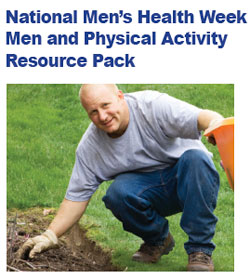My role
- About Us
We want to get a million men moving
 NMHW 2010 will seek to engage men and boys of all ages but with a particular focus on middle-aged (35+) men in routine and manual groups. (This fits well with the new Change4Life priorities.)
NMHW 2010 will seek to engage men and boys of all ages but with a particular focus on middle-aged (35+) men in routine and manual groups. (This fits well with the new Change4Life priorities.)Our target for 2012 is to get the proportion of men aged 35-64 meeting the CMO physical activity targets up to the same level as that for men aged 25-34 (49%) by 2012. This means we want to get just over 1.1m men more active in two years.
We expect local Men’s Health Week events to reach over 250,000 men, our partners to reach over 500,000 men and our media activity to reach over 15m men. In total some 15.75m men will receive Men’s Health Week messaging. Let’s get them moving.
Key messages
The four key messages for men are:
- Physical activity will improve their all-round performance almost immediately. Men who are active will perform better at work (better concentration, cope better with stress, reduced sick leave), in bed (activity boosts sexual performance) and elsewhere. Because of the impact of activity on mental wellbeing, men will also simply feel better. Physical activity is not just about avoiding a heart attack in 20 years time.
- There is a huge choice of activities, including many that men might not have thought or heard about (physical activity is not just about playing football or going to the gym). MHF will develop a prominent signpost to NHS Choices’ soon-to-be-launched ‘Olympic Tool’ which will match an individual’s preferences to the widest possible range of activities (and add local signposting).
- Even the busiest man can find time to do it - activity can be built into a man’s normal daily life – and it can be affordable. Many of the activities can be done at home, alone if preferred or with others (including competitively), or with children.
- Physical activity can improve health, not damage it (many men are deterred by worries about injury or exacerbating existing illnesses). Many men with long-term conditions will find that physical activity may improve their condition, prevent it deteriorating or slow its progression. We are working with Sport England to use their existing research to understand better the barriers to greater physical activity and participation in sport by men and how these might be overcome. We will highlight the support that is widely available already.
The key messages for professionals and policymakers are:
- Although male physical activity levels are generally higher than female, there is still a major problem with men that must be tackled.
- The physical activity participation age-profile is significantly different for men and women.
- There are marked differences in participation between men in different social, ethnic and other demographic groups.
- There are some clear differences between men and women in their attitudes to physical activity, the barriers they experience and how they could be enabled to take part. In turn, these factors require gender-specific responses.
- Sport has a potentially major role in encouraging men to become more active, to improve their lifestyle generally and to make better use of health services. Sports stadia in particular can play an important role.
Page created on April 1st, 2010
Page updated on April 2nd, 2010
Comments
In This Section
Haringey health humour
I'd rather admit I love John Ryan!


 Donate to the MHF
Donate to the MHF
 Man MOT
Man MOT